Gluteal Muscle Anatomy and Exercise
Anatomy of Gluteal Muscle
Gluteus muscle, any of the large, fleshy muscles of the buttocks, stretching from the back portion of the pelvic girdle (hipbone) down to the greater trochanter, the bony protuberance at the top of the femur (thighbone). These include:
1) gluteus maximus
2) gluteus medius
3) gluteus minimus.
1) GLUTEUS MAXIMUS:
This is a large, quadrilateral powerful muscle covering mainly the posterior surface of the pelvis.

ORIGIN:
- Outer slope of the dorsal segment of iliac crest
- Posterior gluteal line
- Posterior part of gluteal surface of ilium behind the posterior gluteal line
- Aponeurosis of erector spinae
- Dorsal surface of lower part of sacrum
- Side of coccyx
- Sacrotuberous ligament
- Fascia covering gluteus medius.
INSERTION:
- The deep fibers of the lower part of the muscle are inserted into the gluteal tuberosity
- The greater part of the muscle is inserted into the iliotibial tract.
NERVE SUPPLY
Gluteus maximus is supplied by Inferior gluteal nerve ( L5, S1, S2)
ACTION:
Gluteus maximus is the chief extensor of the thigh at the hip joint. As this action is very important in rising from a sitting position it is also essential for maintaining an erect posture.
It also acts as:
1. lateral rotator of the hip
2. abductor of thigh
3. this muscle, along with tensor fasciae latae this muscle stabilizes the knee through the iliotibial tract
2. GLUTEUS MEDIUS:
It is a fan-shaped muscle and covers the lateral surface of the pelvis and hips.
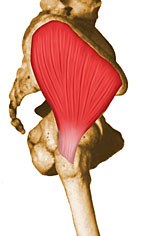
ORIGIN:
It originates from gluteal surface of ilium between the anterior and posterior gluteal lines.
INSERTION:
It inserts into the greater trochanter of femur and on oblique ridge on the lateral surface.
NERVE SUPPLY:
Gluteus medius is supplied by Superior gluteal nerve (L4, L5, S1)
ACTION:
The action of this muscle is:
a) Powerful abductors of the thigh.
b) Also act as medial rotators.
c) Maintain the balance of the body when the opposite foot is off the ground as in walking and running.
3. GLUTEUS MINIMUS
It is a fan-shaped muscle and is covered by the gluteal medius.

ORIGIN
It originates from gluteal surface of ilium between the anterior and posterior gluteal lines.
INSERTION
It inserts into greater trochanter of femur, on a ridge on its anterior surface
NERVE SUPPLY
Gluteus medius is supplied by the Superior gluteal nerve (L4, L5, S1)
ACTION
The action of this muscle are:
a) Powerful abductors of the thigh.
b) Also act as medial rotators.
c) Maintain the balance of the body when the opposite foot is off the ground as in walking and running.
Injury of Gluteal Muscle:
A strained gluteal muscle is a partial or complete tear of the small fibers of the gluteal muscles. The gluteal muscles are a group of 3 muscles in the buttocks.
Causes:
A gluteal strain can be caused by:
a) Stretching the gluteal muscles beyond the amount of tension that they can withstand
b) Suddenly putting stress on the gluteal muscles when they are not ready for the stress
c) A direct blow to the gluteal muscles
RISK FACTORS
Factors that may increase your chance of getting gluteal strain include:
- Participation in sports that require bursts of speed. This includes track sports like running, hurdles, or long jump. Other sports include basketball, soccer, football, and rugby.
- Previous gluteal injury
- Fatigue
- Overexertion
- Tight gluteal muscles
SYMPTOMS
Symptoms may include:
- Pain and tenderness in the buttocks
- Stiffness in the gluteal muscles
- Weakness of the gluteal muscles
- Bruising on the buttocks
TREATMENT:
The muscles will need time to heal. RICE is often the main part of treatment:
Rest—Activities will need to be restricted at first. Normal activities will be reintroduced gradually.
Ice—Ice therapy may help relieve swelling. Heat or cold may be advised throughout recovery if they provide benefits.
Compression—Used for a limited time, compression bandages can provide gentle pressure to help move fluids out of the area.
Elevation—Keeping the area elevated can help fluids drain out or prevent fluids from building up.
Prescription or over-the-counter medications may be advised to reduce pain and inflammation.
Stretching Exercises of Gluteal Muscle:
1. STANDING FOUR-FIGURE STRETCH

- Stand with both hands on the waist.
- Cross one leg over the knee to make a “four” shape and sit with the hips back.
- Keep a tall upper body posture and the core engaged.
- Hold for a few seconds and then repeat on the other leg.
2. SEATED FOUR-FIGURE STRETCH:

- Sit upright in a chair, keeping the spine straight.
- Cross the right leg over the left and place both hands on the shins.
- Lean the torso forward for a deeper stretch.
- Hold for 5 breaths and then place the leg on the floor.
- Repeat on the other side.
3. SEATED TWIST:
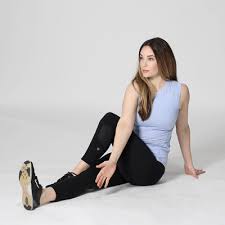
- Start in a comfortable seated position and stretch the legs out in the front.
- Bring the left leg across the right, placing the left foot on the floor and bending the left knee.
- Inhale and stretch the arms overhead, making the spine long.
- Exhale and twist to the left, letting both arms fall comfortably towards the bent knee.
- Breathe in and out and hold for 5 to 10 breaths.
- Untwist and repeat on the other side.
4. GLUTE BRIDGE:
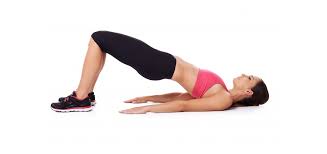
- Lie on the back with the knees bent and the feet flat on the floor.
- Place both feet hip-width distance apart and gently contract the core muscles.
- Gently breathe out while keeping the core engaged and then lift the hips up and off the floor.
- Gently contract the glute (butt muscles) and don’t lift the hips past the point of comfort.
- Hold for 2 to 3 seconds, inhale, and slowly lower the back to the starting position.
- Repeat 8 to 10 times.
5. SEATED HIP ABDUCTION WITH RESISTANCE BAND
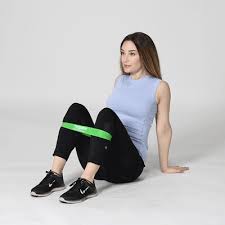
- Sit on the floor and place the resistance band around the calves.
- Bend the knees and keep the feet on the floor.
- Place the hands slightly behind you.
- Keep the back straight and press the legs out to the sides as one externally rotates the hips.
- Gently, and with control, bring both legs back together.
- Repeat 12 to 15 times.
Strengthening exercise for Gluteal Muscle
1. DONKEY KICKS:
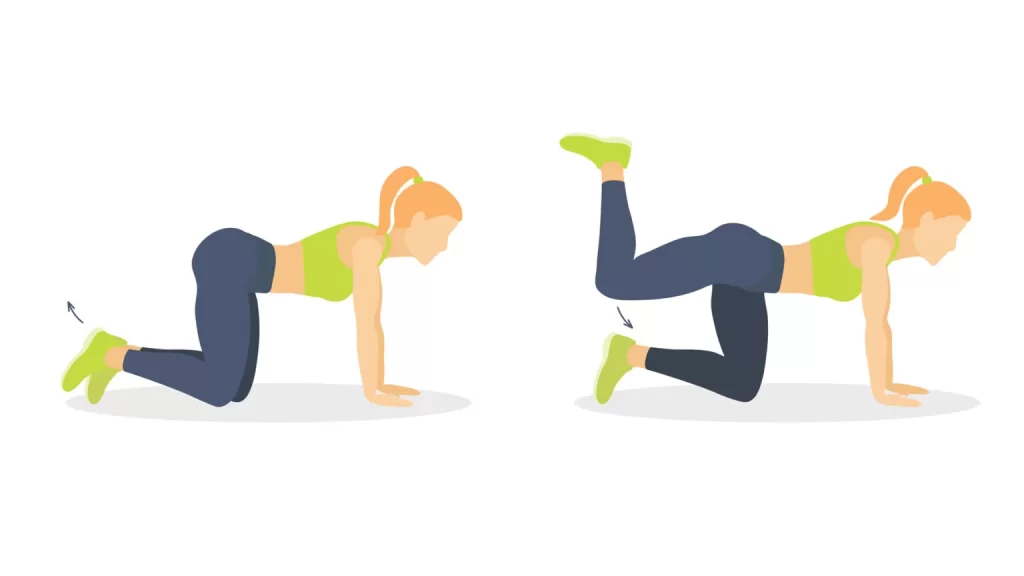
- Get on the ground on all fours with the hands and knees shoulder-width apart.
- Lift the right knee off the ground as one kicks the foot upward so that the thigh is in line with the back and the bottom of the foot is facing skyward.
- One should feel the core, especially the glutes, engaging during this motion.
- Bring the leg back down, repeat, and switch legs.
2. SIDE LEG LIFT:
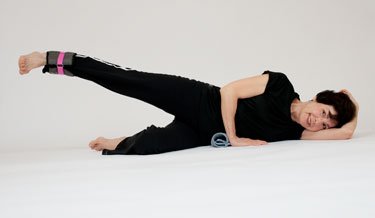
- Lie on the right side with both legs straight and stacked on top of each other.
- One can rest the head on top of the right arm and put the left hand on the hip or on the ground to help balance the body.
- Lift the top leg straight up as far as is comfortable, then lower back down.
- Repeat and switch sides.
3. BODY WEIGHT SQUATS:
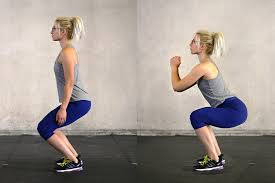
- Stand with the arms extended in front of the body and the feet a little wider than shoulder width with the toes angled somewhat outward.
- Lower the backside down toward the ground as if one were going to sit.
- Lower until the quads are parallel with the ground, then stand back up and repeat.
4. CLAMSHELLS:
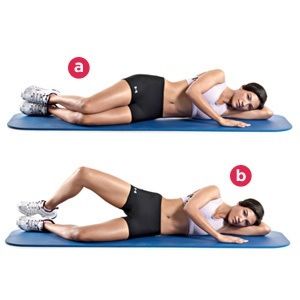
- Lie on the right side with the knees bent on top of each other and the right arm under the head to support it.
- Keeping the feet together, open the clamshell by lifting the top knee up.
- While the hips will rotate during this exercise, be sure that the pelvis and core should remain stable.
- Close the clamshell, repeat, and switch sides.
5. SINGLE LEG SQUAT:

- Stand with the arms extended in front of the body and the feet a little wider than shoulder width.
- Pick the right foot up off the ground, and extend that leg straight out in front of the body.
- Squat down as far as one can while balancing on the left leg, keeping that knee and foot aligned.
- Bring your body back up, repeat, and switch legs.
FAQs
What is the gluteal muscle?
The gluteal muscles, which include the gluteus maximus, gluteus medius, and gluteus minimus, are a collection of muscles that make up the buttock region.
What are the 4 major gluteal muscles?
The gluteal muscles are a muscle group are:
1. Gluteus maximus (strongest muscle in the body)
2. Gluteus medius
3. Gluteus minimus
4. Tensor fasciae latae muscles.
What are three glute muscles?
The gluteal region, sometimes known as the buttocks, is made up of three muscles together referred to as the glutes:
1. Gluteus maximus
2. Gluteus medius
3. Gluteus minimus.
The three muscles are inserted in the femur and come from the ilium and sacral.
Where is the gluteal region?
The proximal end of the femur, posterior to the pelvic girdle, is where the gluteal region is anatomically situated. At the hip joint, the muscles in this area move the lower limb.
What is the main function of gluteal muscles?
Strong gluteal muscles are highly important for pelvic stability, propulsion of the leg during walking and running, and even standing on one leg. Their main function is to hold us upright and propel our bodies forward. Additionally, gluteals support the lower back while lifting and guard against knee problems.
What is the largest muscle in the body?
Gluteus maximus
The biggest muscle in the body is the gluteus Maximus muscle. Strong gluteal muscles are highly important for pelvic stability, propulsion of the leg during walking and running, and even standing on one leg. Their main function is to hold us upright and propel our bodies forward. Additionally, gluteals support the lower back while lifting and guard against knee problems.
Which muscles lift the buttocks?
The three primary muscles that elevate the buttocks and make up the gluteal (butt!) anatomy are the gluteus medius, gluteus maximus, and gluteus minimus.


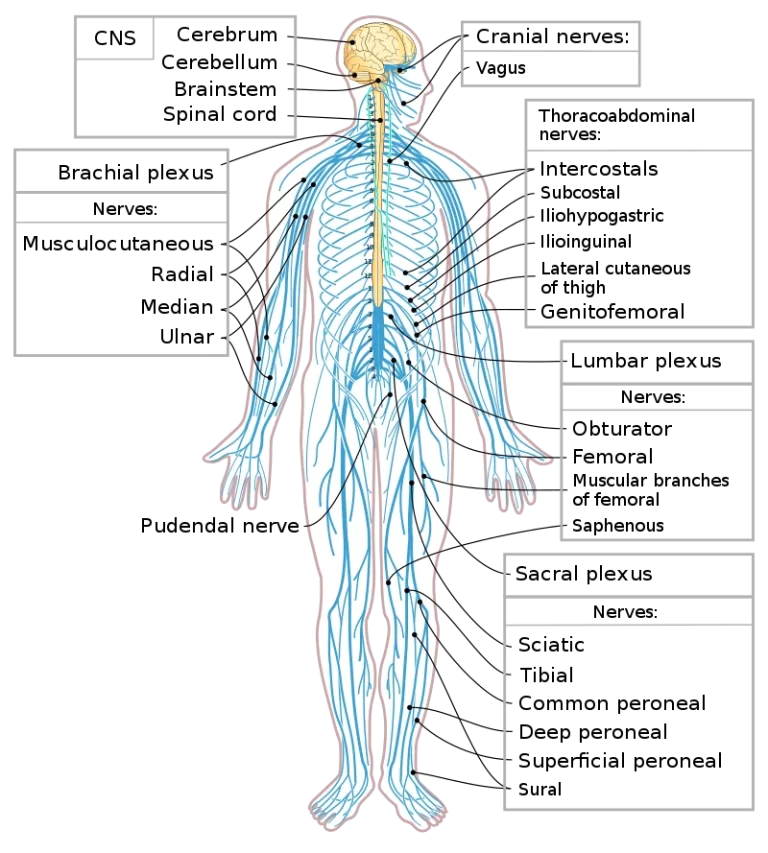
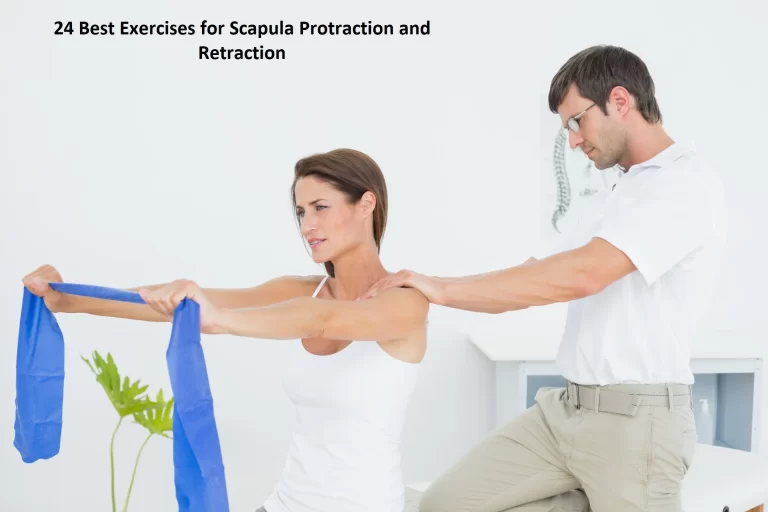
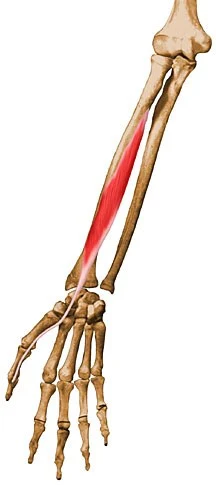

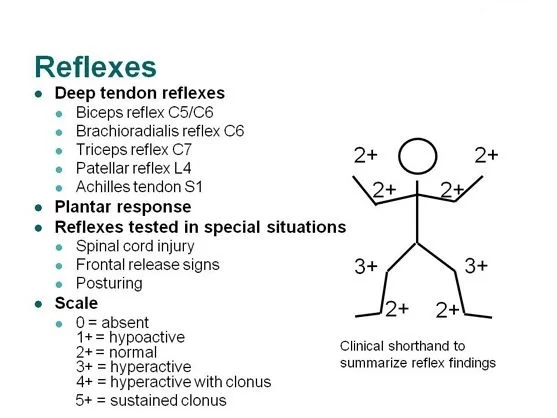
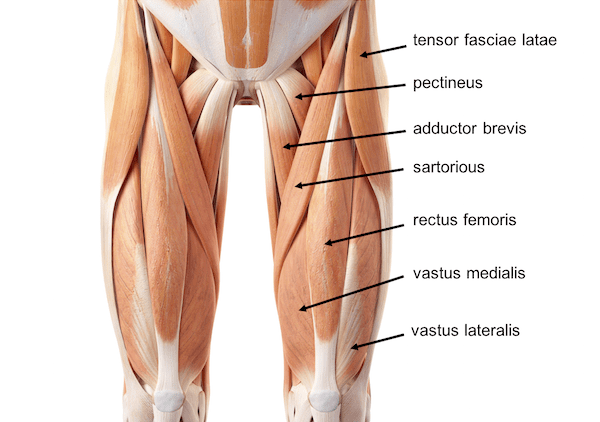
30 Comments